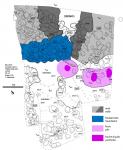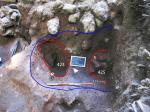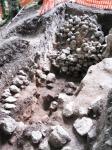Summary (English)
1. Introduction
During the 2015 campaign, the activities were carried out in sector 1 (located on the very top of the mountain, in the so-called “acropolis”), where the dry-wall cultic structure was individuated.
The excavations focused on the southern part of the sector, by the entrance of the dromos of the cultic structure (fig. 1). The campaign was aimed at verifying the construction sequence, through the investigation of two particular structural elements, both already recognized during past campaigns: 1) the containment fillings of the southern side of the structure, realized through the accumulation of local pyroclastic substratum; such fillings seemed to lean against the wall, encasing it, and apparently sustaining a walkway that linked the structure with the lower plateau; 2) the massive dry stone facility (USM 341), that seems to provide a base for the whole structure, and is covered, in turn, by the containment fillings.2. The containment facility
In the past campaigns, in the area immediately before the walled structure, a sequence of fillings was identified, made of volcanic material obtained from the local substratum. The 2015 investigation revealed that such a sequence of fillings is, in fact, very thick (1m average), encasing and containing the walled structure and its foundations, and lying directly on the exposed bedrock. The fillings sequence is made of at least four subsequent layers, of roughly the same thickness. Each layer is characterized by a massive accumulation of rocks (20-40cm) in pyroclastic earth, originally obtained from the local substratum (fig. 2).
It appears that the fillings were laid in order to obtain both a stable containment facility, to contain the walled structure, and an incompressible, walkable surface. The upper surface of the fillings is covered by the collapse of the walled structure, indicating that the surface was exposed at the time the structure collapsed.
On the surface of the fillings, 2 large pits were identified, namely US 317 neg. and US 371 neg., respectively containing one and two postholes (fig. 1, 3). Given their position, leaning against the outer side of the walled structure, it seems very likely that the wooden facility provided a further stability function, in addition to the containment fillings. It seems plausible that, shortly after the laying of the containment fillings, a second operation was required in order to further improve the stability of the eastern side, whereas the western one wouldn’t have required such an intervention. Anyway, the fact that the fillings on both pits are covered by the collapse of the walled structure, indicates that the wooden facility was contemporary to the structure.3. The dry-stone foundation
The massive dry-stone facility USM 341, recognized in the past campaigns, seems to constitute the foundation of the cultic structure. The facility is made of roughly worked stones of ca. 20-40 cm, with a dense and finely realized texture, and possesses a rather regular external curtain (fig. 4). USM 341 is ca. 1m thick, lies directly on the bedrock, and is covered by the containment fillings; the cultic structure proper lies on the top of the facility.
USM 341 is the foundation of the whole structure, with the function of creating an regular platform for the construction of the cultic structure. Its most superficial part constitutes, in fact, the “doorway” of the dromos.4. The materials
The materials, almost exclusively ceramic sherds, are perfectly coherent with those retrieved in all past campaigns: diagnostic elements of a late phase of the Final Bronze Age (mainly combed and “falsa cordicella” – “fake rope” – decorations; FBA 3: ca. 1050-950 BC) are present even in the deepest layers, lying on the bedrock. It appears, therefore, that the cultic structure was relatively short-lived. For the time being, it is not yet clear whether the area was already frequented during the early phases of the FBA and the Recent Bronze Age, both periods attested, instead, in other locations of the site.
- Andrea Cardarelli
- Nicola Ialongo
- Flavia Trucco - Soprintendenza per i Beni Archeologici dell
Director
- Andrea Cardarelli, “Sapienza” Università di Roma
Team
- Andrea Schiappelli-Sapienza – Università di Roma – Matrix 96 Soc. Coop
- Barbara Barbaro- Soprintendenza Archeologia della Liguria
- Francesco di Gennaro- Soprintendenza Archeologia dell’Abruzzo
- Isabella Damiani- Sovrintendenza Capitolina ai Beni Culturali
- Nicola Ialongo- Sapienza Università di Roma
Research Body
- Sapienza – Università di Roma
Funding Body
- Comune di Soriano nel Cimino
- Sapienza Università di Roma






![Download [PDF]](/excavation/skins/fasti/images/results/download_sml.png)


